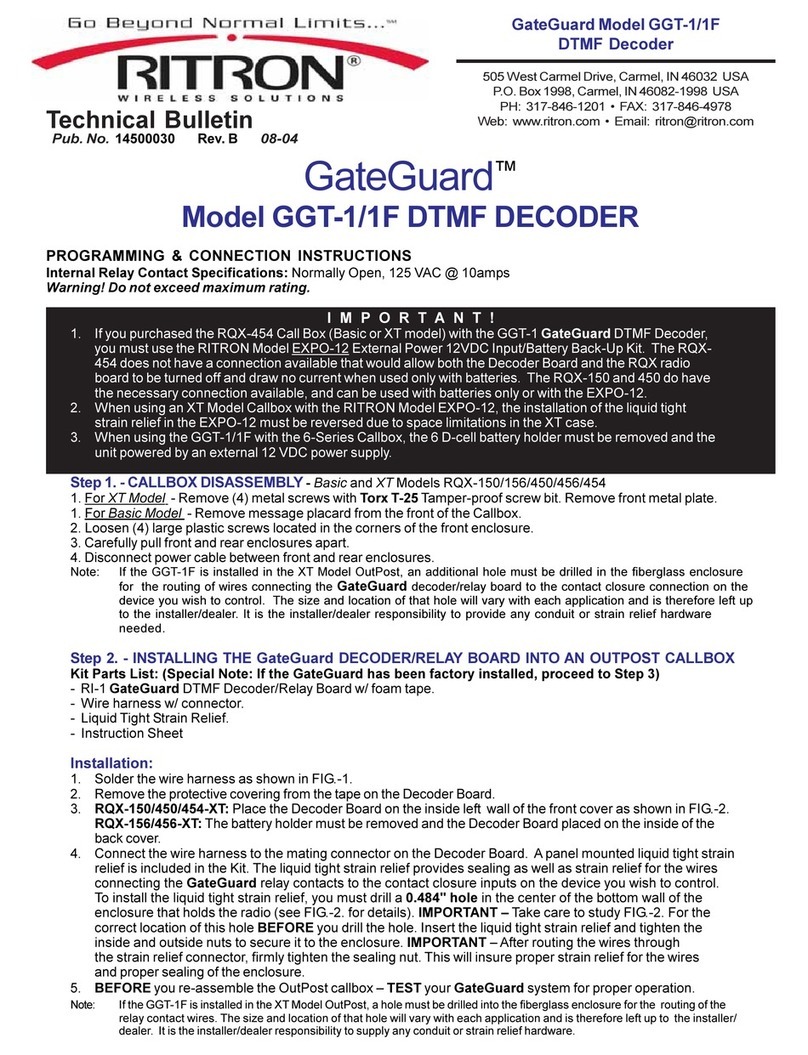Step 4. - CONNECTING THE GateGua d DECODER/RELAY BOARD TO YOUR DEVICE
1. Consult the manufacturer of the device you are attempting to control for the recommended wire gauge.
2. Confirm that your application will not exceed the maximum rating of the internal relay 125 VAC @ 10 amps.
3. Make sure all equipment power is turned off or disconnected.
4. Route all wires through the provided strain relief at the bottom of the Callbox enclosure and any additional strain
relief or conduit. If the XT Model is being used, also route the wires through the drilled or punched hole and any
additional strain relief or conduit.
5. Connect the wire pair between the GateGuard normally open relay contact outputs (refer to FIG.2) and the
contact closure inputs on the device you wish to control.
6. Tighten all strain reliefs and any conduit junctions to ensure moisture/vandal resistance.
Step 5. - CALLBOX RE-ASSEMBLE Basic and XT Models RQX-150/156/450/456/454
Standard Model: R X-150/156/450/456/454
1. Make sure power connectors between front and rear enclosures are connected.
2. Place front and rear enclosures together.
3. Tighten (4) large plastic screws. NOTE: DO NOT over-tighten, damage to screws may result.
4. Basic model - Attach message placard to front enclosure by lining up the push-button in the hole in the
placard and matching up the (4) Velcro pads on the back of the placard.
4. XT model Place metal plate on outer enclosure.
5. XT model Tighten (4) metal screws with Torx T-25 Tamper-proof screw bit.
Basic Ope ation - Model GGT-1/1F DTMF DECODER
The RITRON OUTPOST Radio Callbox with GateGuard installed will operate as such;
After a call has been initiated by the OutPost radio callbox, a two-way conversation can be established between
the callbox and a portable two-way radio. Likewise, personnel with a radio (portable, mobile or base station)
equipped with a DTMF keypad can transmit the access command code back to the OutPost callbox equipped
with a GateGuard decoder. By transmitting the correct GateGuard access command code via the radios keypad,
the user can now achieve long range, wireless remote control to activate motors, gates, locks, lights and/or pumps.
When the GateGuard decodes the correct access command code, the relay contacts will close momentarily (a
1/2-second) to control what has been connected to the relay contacts. The OutPost radio callbox will then
automatically transmit a short (1 second) acknowledgement tone back to the portable radio. This tone
acknowledgement in-turn alerts radio-equipped personnel that the OutPost callbox received and successfully
decoded the GateGuard access command code.
Note: Ackno ledgement Tone and Trunking Operation - If GateGuard is used ith a RITRON Model RQX-454/-XT
programmed for trunking mode through a repeater, the 1 second tone may be partially or entirely missed due to
Home Channel availability.
Rit on Quick Talk Wi eless Voice Ala m Repo te Offe s Wi eless Remote Monito ing
If you would like to know that the desired command was actually per ormed e.g. is the gate really moving?,
then Ritron has the perfect wireless solution for you. We recommend the uick Talk Wireless Voice Alarm
Reporter. The uick Talk R T-150/450/454 can be programmed to the radio system frequency and connected
to any switch i.e. a flex switch, magnetic reed switch, pressure plate etc.. in-turn this switch will be activated by
the actual opening/closing of the gate. A corresponding voice message is then transmitted via radio to all radio-
equipped personnel, providing confirmation on the status of the gate. This useful wireless device can be used in
conjunction with existing two-way radios conventional, repeaters and UHF trunking system and a wide variety
of available switches or sensors.
The 1-second acknowledgement tone generated by the GGT-1 equipped Outpost indicates that a correct
access command code has been received and properly decoded. It does not confirm that the gate is actually
opening or closing; i.e., a damaged gate motor may not be operational. Even though a GateGuard equipped
OutPost callbox receives and decodes the signal, and the relay output closes, the attached device (e.g., a gate
opener) may not be operational. A uick Talk Voice Alarm Reporter along with a flex switch mounted in the path
of the gate will confirm via radio that the gate is actually moving. This added monitoring capability will also alert
radio-equipped personnel of unauthorized movement of the gate. Visit the Ritron web site at www.ritron.com or
call your dealer or Ritron at 800-USA-1-USA (800-872-1-872) for more information on the uick Talk Voice Alarm
Reporter.

























